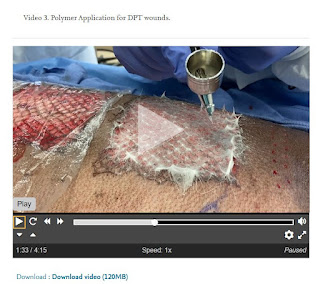“Highlights: Autologous skin cell suspensions sprayed onto wounds can be primarily dressed with a solution-blow spun polymer formulation. Polymer is not cytotoxic to cells and wound beds. Wound closure and scar levels are similar to controls, but usability and sealing of wounds is preferred in polymer-dressed wounds. Abstract: Autologous skin cell suspensions (ASCS) can treat burns of varying depths with the advantage of reduced donor site wound burden. The current standard primary dressing for ASCS is a nonabsorbant, non-adherent, perforated film (control) which has limited conformability over heterogeneous wound beds and allows for run-off of the ASCS. To address these concerns, a novel spray-on polymer formulation was tested as a potential primary dressing in porcine deep partial thickness (DPT) and full thickness (FT) wounds. It was hypothesized that the polymer would perform as well as control dressing when evaluating wound healing and scarring. DPT or FT wounds were treated with either a spray-on poly(lactic-co-glycolic acid) (PLGA) and poly(lactide-co-caprolactone) (PLCL) formulation or control ASCS dressings. Throughout the experimental time course (to day 50), we found no significant differences between polymer and control wounds in % re-epithelialization, graft-loss, epidermal or dermal thickness, or % dermal cellularity in either model. Pigmentation, erythema, elasticity, and trans-epidermal water loss (TEWL), were not significantly altered between the treatment groups, but differences between healing wounds/scars and un-injured skin were observed. No cytotoxic effect was observed in ASCS incubated with the PLGA and PLCL polymers. These data suggest that the novel spray-on polymer is a viable option as a primary dressing, with improved ease of application and conformation to irregular wounds. Polymer formulation and application technique should be a subject of future research.”

No comments:
Post a Comment